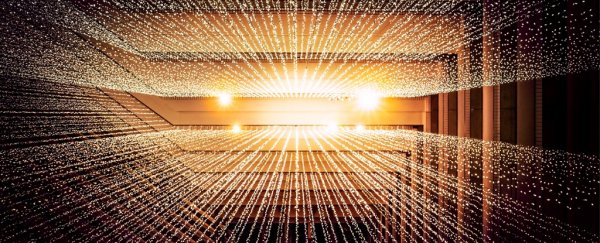It's been exactly 80 years since the theoretical physicist Ettore Majorana predicted that there were neutrally charged particles that were indistinguishable from their own antiparticle. None have been spotted in the wild, and not for want of looking.
Physicists now have the next best thing – a particle-like system that behaves just like the kind of matter Majorana predicted. Not only does it provide experimental evidence of these unique kinds of particles, but it could have applications in the future of quantum computing.
Researchers from Stanford and the University of California made the discovery by forcing electrons to flow in opposite directions along the edges of a sandwich of superconducting materials to collectively give rise to pairs of what are known as quasiparticles.
Don't let the fact quasiparticles aren't bona-fide particles fool you; they still count as far as evidence of certain phenomena goes.
Applying a magnetic field to these particle-like couples as they zipped along caused them to slow down and change direction in distinct stages, a feature that was exploited to spot a kind of behaviour that was a signature of Majorana particles.
"Our team predicted exactly where to find the Majorana fermion and what to look for as its 'smoking gun' experimental signature," says Stanford researcher Shoucheng Zhang.
In homage they named their discoveries "Angel particles", after the Dan Brown thriller Angels and Demons which features a bomb made of antimatter.
If you've ever watched a sci-fi movie (or read a Dan Brown novel), you might have come across this antimatter thing.
In simple terms, for every type of fundamental particle in the Universe there is the equivalent of an evil twin complete with an opposing charge; the negatively charged electron, for example, has a positively charged positron as its antiparticle.
Bringing the two particles together makes them cancel out each other's existence, leaving behind nothing but an intense burst of gamma radiation.
It's that huge pile of radiation that has served as imagination-fuel for all kinds of futuristic space-ship engines and hypothetical weapons of mass destruction.
Particles and antiparticles can go the other way as well, being born together in a concentration of energy such as the ones inside particle colliders, which is how physicists study them today.
Majorana figured there must be particles that are their own antiparticle within the fundamental class of matter known as fermions, which includes things like electrons, neutrinos, and the quarks making up protons and neutrons.
These Majorana particles could also be created as a pair, but would be identical and wouldn't wipe each other out if brought together again.
Photons are good examples of being their own antiparticles, but they aren't fermions.
Neutrons, on the other hand, would be great candidates, since they're already neutral. Unfortunately if neutrons are brought together with anti-neutrons, their opposing group of quarks still annihilate each other.
Another interesting candidate are the tiny, near-massless bits of matter called neutrinos.
Given the difficulty in detecting these ghostly particles, the jury is still out on whether they qualify as Majorana fermions, and will be for some time yet.
It could turn out that such particles just don't exist in the Universe, at least not outside of experiments like these.
That's not to say these results have nothing to contribute to the search of 'real' Majorana particles.
"Where it gets more interesting is that analogies in physics have proved very powerful. And even if they are very different beasts, different processes, maybe we can use one to understand the other. Maybe we will discover something that is interesting for us, too," says researcher Giorgio Gratta, also from Stanford.
Even if the results aren't shocking, the engineering of the experiment itself has been of interest to physicists.
The technology could be used in the future as a way to reduce the risk of a particle in a quantum computer losing its information. A back-up quasi-antiparticle could be just the thing to make the system more robust.
Nobel laureate Frank Wilczek, who wasn't involved in the research, praised the team's ingenuity.
"It's not fundamentally surprising, because physicists have thought for a long time that Majorana fermions could arise out of the types of materials used in this experiment," says Wilczek.
"But they put together several elements that had never been put together before, and engineering things so this new kind of quantum particle can be observed in a clean, robust way is a real milestone."
This research was published in Science.
